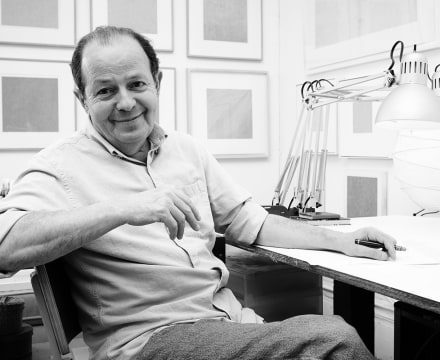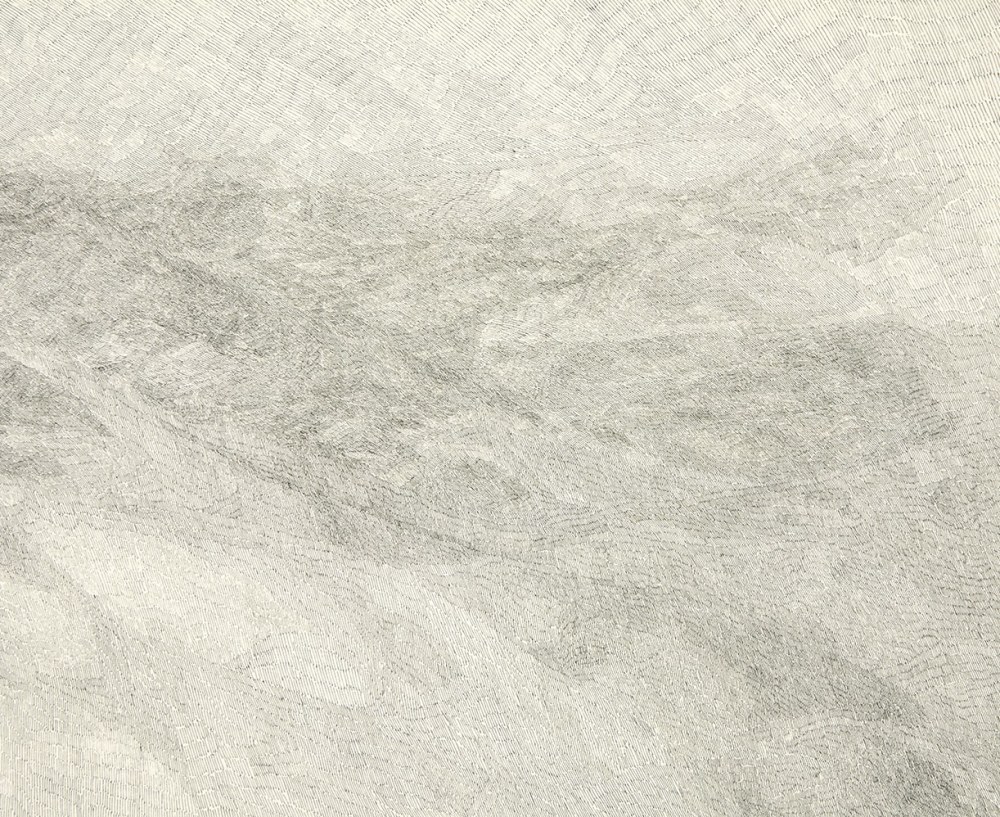

What do the likes of Sir Edmund Hillary, the famed mountaineer credited with the first conquest of Everest, and the scribal mystics of medieval Judaism have in common? Nothing, it would seem—except that they meet in the extraordinary work of Jacob El Hanani. With all the quiet intensity of a monk absorbed in selfless devotion to the word of God, and a considerable dose of climber’s hubris, El Hanani has made a career out of testing the limits of human endurance. Armed with only a fine-point pen and the discipline of a military general, this artist has brought drawing to places few of us might care to go. But experienced from the armchair of viewership, the work is as breathtaking in its beauty as it is profound in its implications about the human urge toward—and need for—self-transcendence.
With this show, the Israeli artist’s first New York solo in over a decade, we have a rare opportunity to see a range of drawings created in the last eight years. Acquavella’s cavernous interior is an apt setting for the thirteen modest- to mid-sized pieces on view; both stately and austere, it echoes the work’s curiously dual nature. Bright, open, and largely devoid of sensory distractions, the space encourages exactly the kind of viewing demanded here: close, concentrated, and sustained.
The emphasis is on close, for it is by no bit of admirer’s hyperbole that El Hanani is known as the “grandfather of micro-drawing.” Indeed, from the conventional viewing distance, one sees only soft rectangles of atmospheric haze surrounded by generous margins of untouched paper. But at nose distance, innumerable discrete marks emerge—some no larger than a particle of dust—whose dense accretions coalesce into the shimmering fields we see from a few steps back. While the marks vary from tiny linear strokes to long hair-like strands to letters from the Hebrew alphabet, the abstract images they form evoke landscapes, ambiguous cartographies, or, most overtly, textiles. But as Arthur Danto suggested in the show’s catalogue essay, the images are epiphenomenal to the work’s primary focus: the marks themselves. That the latter are hand-drawn—a fact crucial to the work’s appreciation—is evident within every inch of drawn surface: wobbly, irregular, and subtly varied in weight and density, the lines exude human presence.
While the unfathomable labor-intensiveness of the artist’s practice—what we might call its “wow factor”—announces itself with much volume, the work is rooted in a tradition born of devotional silence. An element of kabbalic exegesis, the scribal art of micro-calligraphy, in which minuscule Hebrew letters are used to compose images adorning sacred texts, dates back some thousand years. The sanctity of the Hebrew alphabet being a fundamental tenet of the kabbalah, one can imagine the impulse that gave rise to this practice. If the letters were thought to be the means by which God brought the world into being, intimate and prolonged contact with them brought the artist-scribe into Divine communion. Like chant or incantation, it is a meditative practice whose use of language transcends the latter’s rational dimension, transforming it into a vehicle for ecstatic experience.
While allusions to sacred writing are implicit throughout, some of the drawings bear their origins more conspicuously than others. The Hebrew Barbed Wire(2013) is one of the most explicit in this regard. Here, undulating threads of Hebrew text crisscross an expansive horizontal field. The reader of Hebrew might wish for a magnifying glass, but ultimately the work’s appeal lies not in what it says but in the intensity of the process by which it was brought into being. In other drawings, such as those in the particularly beautiful “Linescape”series (2012), letters give way to loose parallel hatches whose irregular swirls suggest tempests (indeed, the series’s subtitle gives a nod to J.M.W. Turner). In the show’s densest piece, Crosshatched (1999), the pockets of negative space that punctuate the other drawings are all but abandoned. Here, microscopic clusters of crosshatched lines create an allover field so vibratory and alive it is virtually palpable. The effect is one of an unusually acute—and largely ineffable—attunement with Being.
Perhaps it is in this awakening of our subtler senses that the work achieves its greatness. If so, it is an experience that can arise only after one’s awe over the work’s facture has settled—or, otherwise put, once the artist himself has receded from the picture. And herein lies the work’s central paradox: for all its strenuous asceticism, there is an element of egotism in El Hanani’s practice. After the initial “Wow,” it is difficult not to dwell on the question of “How,” which can hinder deeper, more substantial contemplation. The sheer feat that each piece represents can be a distraction. It is a danger that plagues much “endurance art,” not unlike that which can threaten to turn work of monumental scale into mere spectacle.
But perhaps there is another way of understanding the work’s allure. The urge toward self-transcendence, which is the impulse behind all ecstatic disciplines, would not exist were the self not conflicted. Twofold always—with longings for both singularity and identification with a larger whole—we are all, in this sense, a problem to ourselves. With equal parts hubris and humility, El Hanani’s work is a powerful testament to a human pathos that reaches in both directions. And just as Edmund Hillary was less singular in his accomplishment than he might have liked us to believe (we now know he was accompanied by Tenzing Norgay, an intrepid Sherpa), El Hanani is preceded by many an equally possessed mind striving for self-conquest. But in the realm of contemporary drawing, he stands on that mountain alone.